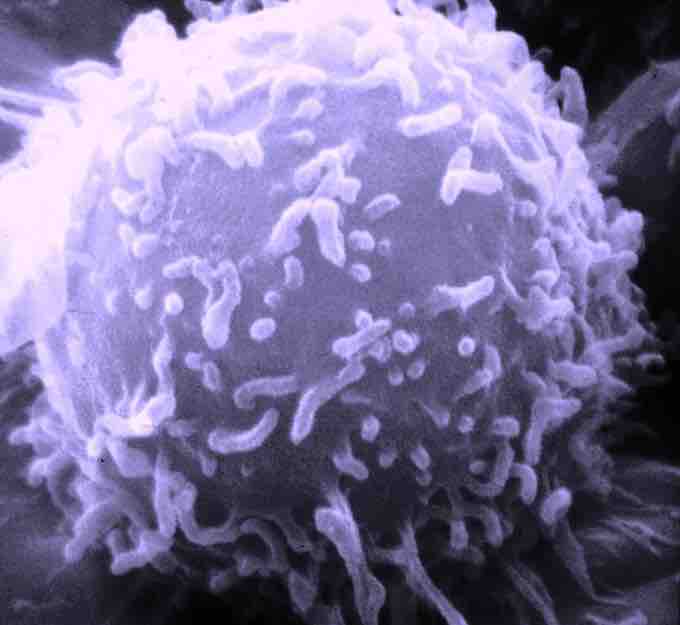A lymphocyte is a type of white blood cell in the immune system, including both the B and T cells of the adaptive immune system and natural killer (NK) cells of the innate immune system .
B and T cells and their various subdivisions perform many adaptive immune functions.
T Cells
T cells mature in the thymus and contain T cell receptors (TCRs) that allow them to bind to antigens on MHC complexes. T cells are a major component in cell-mediated adaptive immunity because they provide a pathway for the direct killing of pathogens. There are two main types of T cells that express either CD4 or CD8 depending on signals that occur during T cell maturation, as well as less common types:
- Helper T cells (CD4s) facilitate the organization of immune responses, and can bind to MHC class II. Subtype 2 helper T cells present antigens to B cells. Subtype 1 helper T cells produce cytokines that guide cytotoxic T cells to pathogens and activate macrophages.
- Cytotoxic T cells (CD8s) destroy pathogens associated with an antigen. They function similarly to NK cells by binding to MHC class I and releasing perforin, granzymes, and proteases to induce apoptosis in a pathogen. They are different from NK cells because they only bind to cells that express their specific antigen, and are not large or granular like NK cells.
- Suppressor T cells (T-reg cells) retain some of their ability to bind to self-cells. They have an immunosuppressive effect that inhibits cell-mediated immunity at the end of a response and destroys autoimmune T cells that aren't filtered out by negative selection in the thymus.
- Memory T cells are created after an adaptive immune response subsides, retaining the presented antigen. They rapidly proliferate and differentiate into helper and cytotoxic T cells that are specific to that antigen should it be detected in the body again.
While these are the main categories of T lymphocytes, there are other subtypes within these categories as well as additional categories that are not fully understood.
B Cells
B cells are involved in humoral adaptive immunity, producing the antibodies that circulate through the plasma. They are produced and mature in bone marrow tissues and contain B cell receptors (BCRs) that bind to antigens. While in the bone marrow, B cells are sorted through positive and negative selection in a manner somewhat similiar to T cell maturation in the thymus, with the same process of killing B cells that are nonreactive to antigens or reactive to self-antigens. Instead of apoptosis, though, defective B cells are killed through other mechanisms such as clonal deletion. Mature B cells leave the thymus and travel to secondary lymphoid tissue such as the lymph nodes.
During antigen presentation, antigen-presenting cells first present antigens to T cells. Then mature helper T cells bind their antigen to naive B cells through BCRs. After antigen presentation, the naive B cells migrate together to germinal centers within the lymphoid tissue, where they undergo extensive proliferation and differentiation into different types of mature B cells. Some of the major categories of B cells that arise include:
- Plasma cell and long-lived B cells that are the main source of antibodies. They do not have the ability to proliferate and are considered terminally-differentiated.
- Plasmablasts are short-lived B cells produced early in an infection. Their antibodies have a weaker binding affinity than those of plasma cells.
- Regulatory B cells (B reg cells) are immunosuppresive B cells that secrete anti-inflammatory cytokines (such as IL-10) to inhibit autoimmune lymphocytes.
- Memory B cells are dormant B cells with the same BCR as the B cell from which they differentiated. They are specific to the antigen presented to that BCR and rapidly secrete large amounts of antigen-specific antibodies to prevent reinfection if that antigen is detected again.
Besides antibody production, B cells may also function in antigen presentation, though not to the degree of macrophages or dendritic cells. B cells are important to adaptive immune function but can cause problems as well. Autoreactive B cells may cause autoimmune disease that involves antibody-induced damage and inflammation. Certain B cells may undergo malignant tranformation into cancer cells such as lymphoma, in which they continually divide and form solid tumors.

Lymphocyte
A scanning electron microscope (SEM) image of a single human lymphocyte.